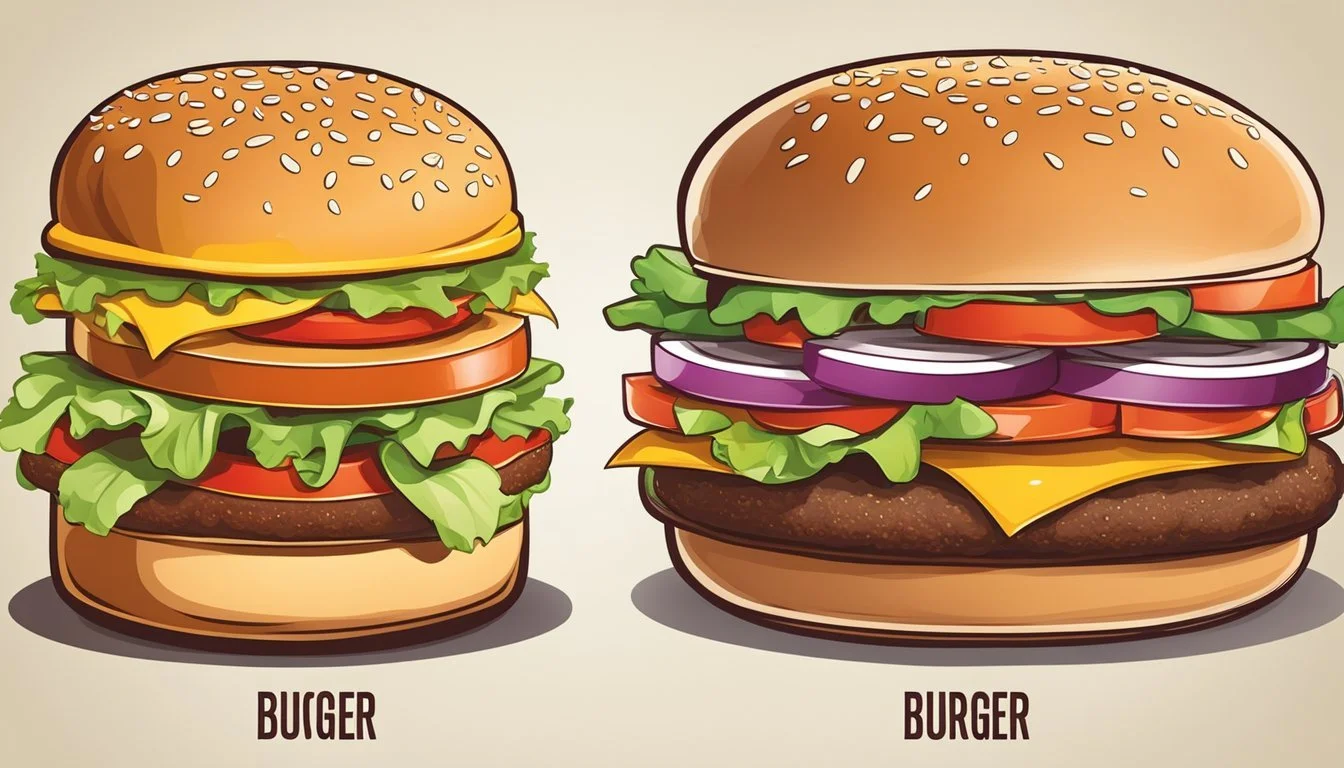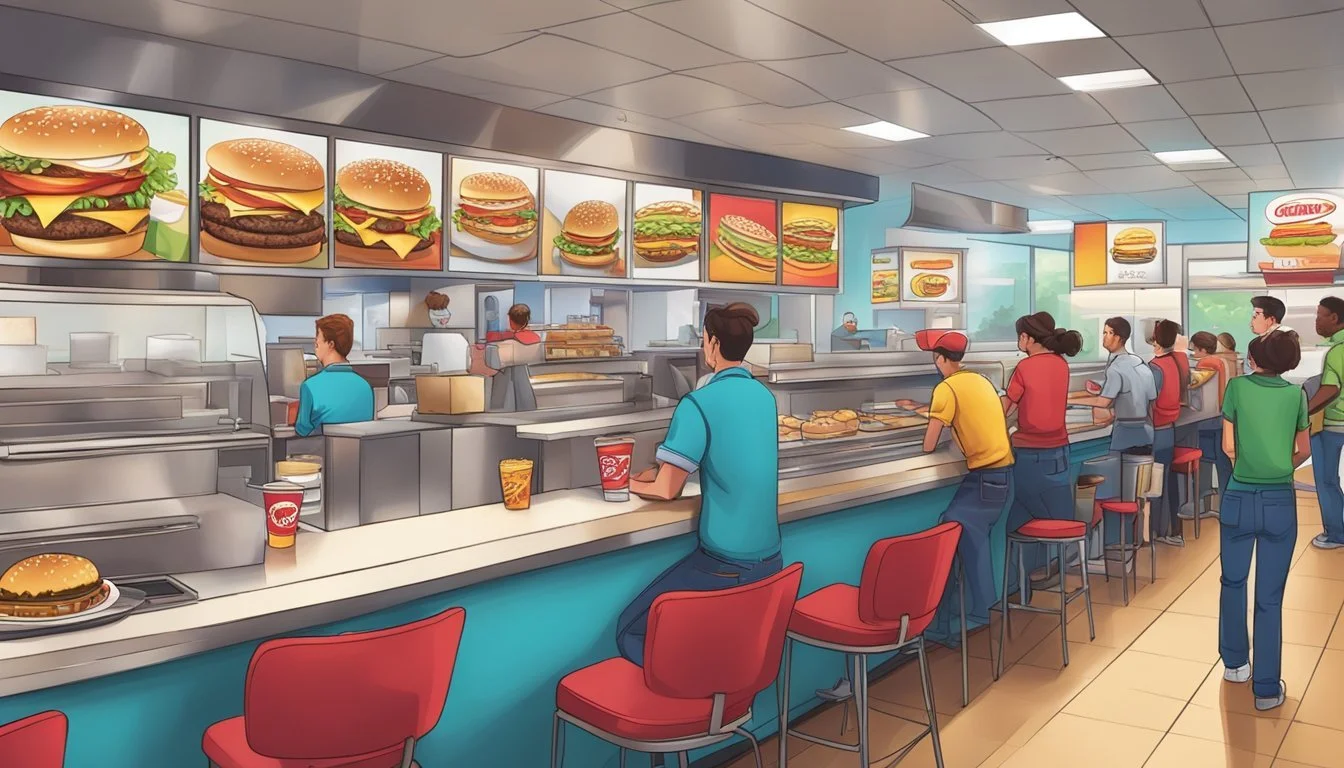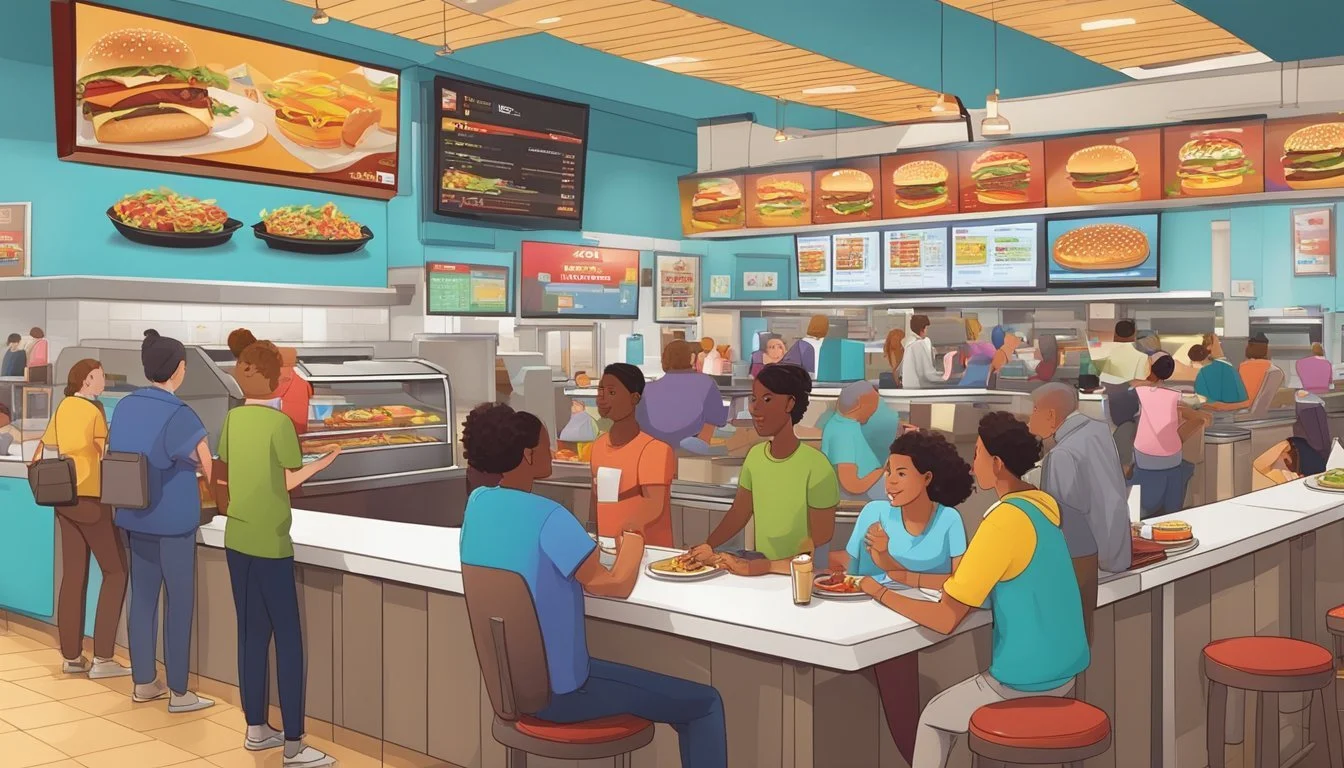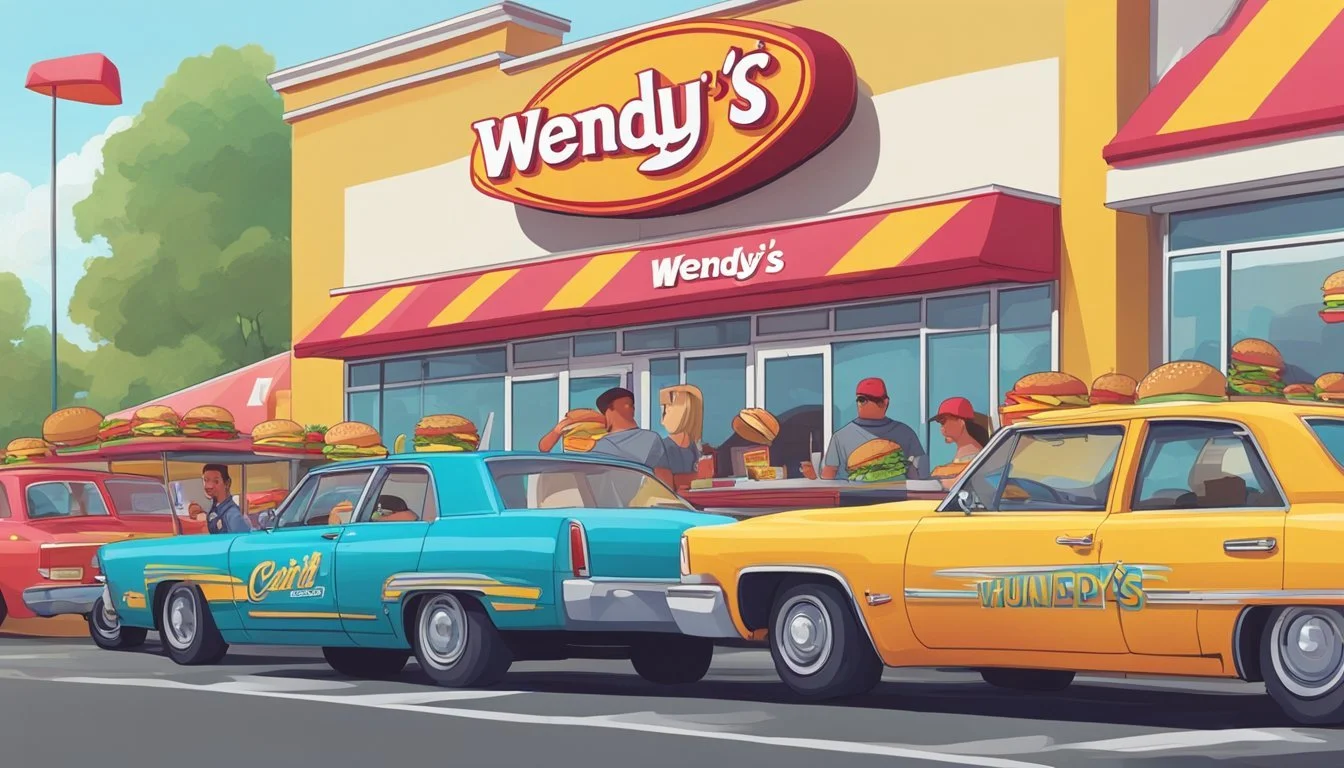Wendy's vs Carl's Jr
A Comprehensive Comparison of Burger Restaurants
When it comes to fast-food burgers, the rivalry between Wendy's and Carl's Jr. is a topic of frequent debate among burger aficionados. Both chains offer a distinctive array of burgers, featuring their unique approaches to what constitutes the quintessential fast-food experience. Wendy's, renowned for its square patties and fresh ingredients, boasts more than 5,500 locations nationwide, suggesting a firm grasp on the fast-food market.
Carl's Jr., on the other hand, promotes its charbroiled burgers, aiming to deliver a more upscale, sit-down restaurant-quality burger within the fast-food space. A perfectly adequate burger for many, Carl's Jr. presents a different philosophy in burger making and has its own dedicated following. Consumers often decide their preference based on various factors, including the taste, quality, variety, and the overall dining experience at each establishment.
Brief History of Wendy's and Carl's Jr.
The battle between Wendy's and Carl's Jr. hinges on their historical evolution from humble beginnings to their status as burger empires. This section provides an insightful look into the inception and growth of these two fast-food giants.
Wendy's Beginnings
Wendy's was founded by Dave Thomas in 1969, with the first restaurant opening in Columbus, Ohio. Thomas created Wendy's with the idea of providing high-quality, made-to-order hamburgers. His concept quickly resonated with customers, setting the stage for the chain's expansion. Characterized by square hamburger patties that hang over the edge of a circular bun, Wendy's became known for its fresh, never frozen, beef—making it a distinctive player in the fast-food arena.
Carl's Jr. Expansion
Carl's Jr., on the other hand, traces its roots back further to 1941. Carl Karcher and his wife Margaret started with a hot dog cart in Los Angeles. Their venture was successful enough to enable the opening of a full-service restaurant named Carl's Drive-In Barbecue in 1945. The first official Carl's Jr. locations—named for the smaller, express version of Karcher's original restaurant—were established to capitalize on the growing fast-food market. The expansion strategy proved effective, with Carl's Jr. developing a reputation for juicy, charbroiled burgers, encapsulating the quintessential West Coast style.
Menu Comparison
When comparing Wendy's and Carl's Jr., their menus feature a range of burger variations, signature items, and sides, each with a unique approach to fast food fare.
Burger Variations
At Wendy's, customers can enjoy classics like the single, double, or triple hamburger, each layered with cheese, toppings, and a signature square beef patty which signifies its fresh, never frozen, beef. Wendy's also offers a variety of chicken sandwiches and a notable bacon cheeseburger.
Carl's Jr., on the other hand, is known for the Big Carl and the indulgent Western Bacon Cheeseburger. Their menu allows for a diverse burger experience including charbroiled beef patties and options like the double cheeseburger and Super Star with Cheese.
Signature Items
Wendy's flagship burger, the Baconator, is a bacon cheeseburger featuring two beef patties, American cheese, six pieces of crispy applewood smoked bacon, ketchup, and mayo on a bun. They also boast about their chili and frosty as non-burger standouts.
The Western Bacon Cheeseburger is a hallmark for Carl's Jr. with its charbroiled beef patty, American cheese, crispy bacon, onion rings, and BBQ sauce. They are also recognized for daring limited-time offers that often bring unique flavors to their menu.
Sides Assortment
A fast food meal is often not complete without sides. Wendy's offers a range of sides including natural-cut fries seasoned with sea salt, chili, and their flavorful, tangy sea salt and vinegar potato chips.
Carl's Jr. differentiates its sides with options such as onion rings, crisscut fries, and fried zucchini. Their hand-breaded chicken tenders also serve as a popular side option or even a meal in itself.
In both restaurants, condiments such as ketchup, mustard, and mayo are readily available for extra flavor customization.
Nutritional Content Analysis
When assessing the nutritional content of Wendy's and Carl's Jr. burgers, a primary focus rests on calorie counts and ingredient quality. These factors significantly influence a burger's health implications and can guide consumers' choices.
Calorie Counts
Calorie content is a major consideration for those monitoring their dietary intake. Wendy's offers a range of burgers, from the Jr. Hamburger at around 240 calories to the Dave's Triple, which can exceed 1,000 calories. In contrast, Carl's Jr. features the Famous Star burger starting near 670 calories, with the Really Big Carl towering at 1,180 calories based on reported nutritional information.
Wendy's:
Jr. Hamburger: ~240 calories
Dave's Triple: >1,000 calories
Carl's Jr.:
Famous Star: ~670 calories
Really Big Carl: 1,180 calories
Ingredient Quality
Regarding ingredient quality, both chains boast use of fresh, never frozen beef in their patties, enhancing the flavor and texture of the burgers. Wendy's highlights its use of fresh beef patties in its square-shaped burgers, often seen as a signature feature. Carl's Jr., known for its charbroiled burgers, emphasizes the smoky, grilled flavor imparted by this cooking method.
In terms of specific ingredients, pickles are a common burger topping that can vary in quality. Wendy's and Carl's Jr. appear to use standard dill pickles. Meanwhile, American cheese, another staple in fast-food burgers, is used by both brands to add a creamy and mild flavor to their burgers. Wendy's and Carl's Jr. both offer a variety of toppings and sauces allowing consumers to customize their burgers to preference, which can also affect the nutritional content, particularly the calorie count.
Price and Value Proposition
In comparing Wendy's and Carl's Jr, a key focus is on how these burger joints balance the price of their offerings with the perceived value to the consumer. Both chains strive to offer competitive pricing, but they also emphasize different aspects of their menus to appeal to value-conscious customers.
Cost Effectiveness
Wendy's boasts a junior hamburger priced at $1.49, representing a cost-effective option for those seeking a quick and affordable meal. On the higher end, they offer a triple bacon jalapeño cheeseburger costing $8.59, which seems to be their most expensive burger option. Meanwhile, Carl's Jr. presents its own array of burger prices, though specific price points weren't detailed in the provided search results.
Value Menu Offerings
Wendy's Value Menu highlights a variety of choices that provide customers with both affordability and taste. They work to deliver a balance between cost and satisfaction, ensuring customers feel they receive good value for their money. Carl's Jr. similarly has offerings that cater to budget-minded individuals but emphasizes unique, bold flavors in their promotional endeavors.
Both chains are known to include popular items like medium fries as part of their value-focused selections, often bundling them with other items to enhance the overall value proposition. They consistently update their menus to ensure that cost-conscious consumers can find a combination of items that meet their price preferences.
Customer Experience
When choosing a fast-food burger chain, customer experience plays a significant role in defining preference. Factors such as the dining atmosphere, customer service quality, and ordering convenience directly influence the overall satisfaction.
Dining Atmosphere
Wendy's and Carl's Jr. both offer a distinct dining atmosphere. Wendy's typically presents a modern and welcoming environment with well-lit dining areas and comfortable seating. The decor incorporates a mix of warm colors and features their iconic red-headed mascot. In contrast, Carl's Jr., known for its more laid-back, edgy branding, often has a casual, relaxed vibe that can be attractive to younger demographics.
Customer Service Quality
The quality of service at Wendy's is consistently reviewed as efficient and friendly. Wendy's employees are often recognized for their courtesy and swift response to customer needs, which reflects positively on the brand. Carl's Jr. also strives to provide good customer service but has received mixed reviews in different locations. Some customers report excellent service, while others have encountered less favorable experiences.
Ordering Convenience
In terms of ordering convenience, both burger chains capitalize on various platforms to improve the customer's experience. Wendy's and Carl's Jr. offer drive-thru services that are noted for their fast and accurate order fulfillment. Additionally, they both utilize user-friendly mobile apps for convenient online ordering. Wendy's has been slightly ahead in this area, having introduced mobile payment options and rewards programs earlier than Carl's Jr.
Both brands aim to provide a customer experience that meets the demands of fast-paced, quality-conscious diners seeking convenience and satisfaction in their fast-food choices.
Brand Identity and Marketing
In the fast-food industry, brand identity and marketing are crucial for distinguishing one burger joint from another. Wendy's and Carl's Jr. have crafted distinct brand personalities through their advertising campaigns and the cultural impact of their marketing.
Advertising Campaigns
Wendy's marketing strategy capitalizes on a varied menu that appeals to a wide range of tastes with an emphasis on 'fresh, never frozen' beef, portraying themselves as a higher-quality option among fast food chains. They have crafted campaigns that are often direct, such as the famous "Where's the Beef?" slogan, which questioned the beef quality of competitors like McDonald’s and Burger King.
Carl's Jr., on the other hand, has historically utilized provocative and attention-grabbing commercials featuring celebrities. Carl's Jr.'s marketing efforts have aimed to differentiate the brand from other fast-food restaurants by highlighting indulgent experiences associated with their bigger, bolder burger offerings.
Cultural Impact
Wendy's has left an indelible mark on pop culture with its straightforward and often witty social media presence, especially on platforms like Twitter where they engage directly with other fast food giants like McDonald's. Their approach to branding has been inclusive and light-hearted, which has fostered a strong connection with a younger audience.
Carl's Jr., meanwhile, has shaped its brand identity with a deliberate blend of edginess and luxury, suggesting that their burgers are not just a fast food option but a choice of indulgence. While their branding has evolved, the core idea remains creating a sense of premium, albeit casual, dining experience.
Both Wendy’s and Carl’s Jr.’s branding efforts are instrumental in carving out their respective places in a market dominated by the Golden Arches of McDonald's and the longstanding heritage of Burger King. Their identities resonate with customers beyond just the price and taste of their burgers, solidifying their presence in the competitive landscape of fast food marketing.
Loyalty Programs and Promotions
Wendy's and Carl's Jr. are well-known for their competitive loyalty programs. Wendy's Rewards was introduced to incentivize customers through a points-based system. Members earn points for each dollar spent, which can be redeemed for free food items on subsequent visits. Its popularity is evidenced by its 3 million members. The program is tailored to increase repeat visits and bolster customer retention.
Carl's Jr., on the other hand, has yet to implement a corporate-wide points-based loyalty program akin to Wendy's Rewards. Despite this, Carl's Jr. franchises may offer store-specific promotions and punch card systems. These promotions encourage customers to return by providing them with incentives such as a free item after a certain number of purchases.
Both companies regularly engage customers with time-limited promotions. These often include discounts on particular menu items, value meals, and special edition foods tied to events or seasons.
Wendy's
System: Points-based system
Promotions: Store-specific promotions
Membership: 3 million members
Engagement Levels: Varied engagement levels
Carl's Jr.
System: Punch cards (select locations)
Promotions: Store-specific promotions
Membership: Not specified
Engagement Levels: Not specified
Neither brand solely relies on their loyalty programs. They also utilize social media, mobile apps, and advertising campaigns to offer promotions directly to consumers. These strategies are designed to adapt to customer behaviors and preferences.
In summary, Wendy's has a more structured and unified loyalty program with widespread adoption. Carl's Jr. provides varied customer incentives that may differ between franchises, which offers local flexibility but lacks the cohesion of a single, brand-wide system.
Social Media Presence and Engagement
When analyzing the social media landscape, Wendy's maintains a notable presence with its strategic use of humor and interaction. It leverages platforms like Instagram and particularly Twitter, where the brand has become well-known for its witty and often humorous replies. Wendy's distinct voice on these platforms allows it to engage customers effectively, encouraging interactions that often go viral.
Twitter Followers: Wendy's has amassed over 3.8 million followers, indicative of its social media influence.
Engagement Style: Characterized by quick, clever comebacks and engaging with other brands and users.
On the other hand, Carl's Jr. presents a more traditional social media approach, focusing on product promotion and highlights. While Carl's Jr. does interact with its customer base, it has not cultivated an identity on social media that is as distinctive as Wendy's.
Engagement Strategy: Carl's Jr.'s method includes more straightforward marketing and less interactive banter compared to its competitor.
In the arena of customer engagement, Wendy's strategy has helped it stand out from other fast-food chains, offering a unique personality that resonates with social media users. The brand's approach can be considered bold and culturally in tune, allowing it to connect with customers on a level that not only encourages brand loyalty but also drives social conversation.
Carl's Jr., while maintaining a respectable social media presence, has not embedded itself into the social media culture as deeply as Wendy's, impacting its ability to connect with the online community in the same manner.
Environmental and Social Responsibility
When comparing Wendy's and Carl's Jr., their commitment to environmental sustainability and community engagement are significant factors. They both recognize the impact of their operations on the planet and the importance of corporate responsibility.
Sustainability Initiatives
Wendy's has placed an emphasis on reducing greenhouse gas emissions and responsible sourcing. Notably, the company has set out clear targets for sustainably sourcing their packaging materials and reducing waste. Wendy’s has committed to various sustainability initiatives under their corporate responsibility strategy, aiming for a significant reduction in environmental footprint.
On the other hand, Carl's Jr. has made strides by introducing plant-based options to their menu, catering to a growing demand for sustainable food choices. While specific environmental goals are not as publicly detailed as Wendy's, Carl's Jr. has shown an evolving approach to sustainability, recognizing its importance in the fast-food industry.
Community Involvement
Wendy's demonstrates community involvement through its 'Good Done Right' platform, focusing on creating equitable workplaces and supporting local communities. This involvement is reflected in their commitment to fostering a supportive work environment and their dedication to community enrichment.
Carl’s Jr. also contributes to communities but tends to do so through local initiatives and partnerships, such as fundraising events and charitable contributions. These efforts show that Carl's Jr. values community engagement and works to maintain a positive impact within their reach.
Geographic Availability
In analyzing the geographic availability of Wendy's and Carl's Jr., it is essential to consider their national presence and international expansion strategies.
National Presence
Wendy's operates primarily in North America, with a substantial presence in the United States where it originated. As of the knowledge cutoff in 2023, Wendy's had more than 6,700 locations across the country. This extensive network ensures that Wendy's is accessible to a vast majority of the American population.
Carl's Jr., on the other hand, shares a common parent company with Hardee's, known as CKE Restaurants. Together, they feature a considerable number of outlets in the United States. Specifically, Carl's Jr. is well-established in the Western and Southwestern regions, with hundreds of outlets that cater to a loyal customer base in these areas.
International Expansion
Wendy's international footprint extends beyond the US borders with locations in several countries. These international ventures add to the company's global presence, allowing it to serve customers across continents.
In contrast, Carl's Jr. has shown ambition in its international expansion efforts. The brand has established a presence in numerous countries, bringing its distinctive menu items to a global audience. Carl's Jr.'s strategic openings in key international markets underscore its commitment to growing its brand outside of the United States.
Consumer Reviews and Ratings
In evaluating Wendy's and Carl's Jr., consumer reviews and ratings provide crucial insights into public perception and satisfaction. Review platforms and customer feedback suggest differing opinions highlighting distinct experiences at each burger joint.
Wendy's is recognized for its commitment to fresh, never-frozen beef, often resulting in positive reviews for burger quality. Customers frequently commend the taste of Wendy's burgers and their variety. Ratings on various consumer platforms tend to hover around 4 out of 5, with particular praise for the chain's signature square patties.
Freshness of beef: 4.5/5
Taste of burgers: 4/5
Variety offered: 4/5
Carl's Jr., known for its charbroiled burgers, also garners a dedicated customer base. Consumers often rate their burgers as flavorful and satisfying, with attention paid to their Super Star burger with cheese. Consumer ratings typically average between 3.5 and 4 out of 5, reflecting satisfaction with the quality and taste of their offerings.
Flavor of charbroiled burgers: 4/5
Satisfaction with menu options: 3.5/5
Quality of ingredients: 4/5
In summary, reviews and ratings from consumers showcase strengths in both Wendy's and Carl's Jr. While Wendy's receives accolades for freshness and taste, Carl's Jr. is recognized for its flavorful charbroiled burgers and satisfying menu options. These consumer opinions portray a competitive landscape where both burger joints deliver distinct qualities appreciated by their respective patrons.
Conclusion
When comparing Wendy's and Carl's Jr., it's evident that each franchise has built a distinctive identity within the fast-food landscape. Wendy's has established itself with its signature square patties and fresh, never frozen, beef, while Carl's Jr. is known for its charbroiled burgers and Western-themed menus.
Wendy's Strengths:
Fresh beef that is never frozen
Unique square burgers, setting them apart visually
A reputation for high-quality ingredients in their offerings
Carl's Jr. Strengths:
Charbroiled burgers offering a distinct taste profile
A varied menu including options like the Western Bacon Cheeseburger
High-caliber promotional campaigns that create buzz
Consumers often choose Wendy's for the guarantee of freshness and the classic taste, whereas Carl's Jr. draws in customers seeking a bolder flavor profile and heartier sandwich options.
Price points and availability can influence diner preferences; Wendy's expansive franchise network provides more extensive accessibility, while Carl's Jr. has a more targeted geographic presence.
In terms of nutritional considerations, both chains provide detailed information on caloric intake and ingredient lists, empowering customers to make informed choices fitting their dietary needs.
Ultimately, the better burger joint may simply come down to personal taste and priorities. Whether prioritizing a distinct charbroiled flavor or the guarantee of freshness, burger enthusiasts can find satisfaction at either Wendy's or Carl's Jr.












